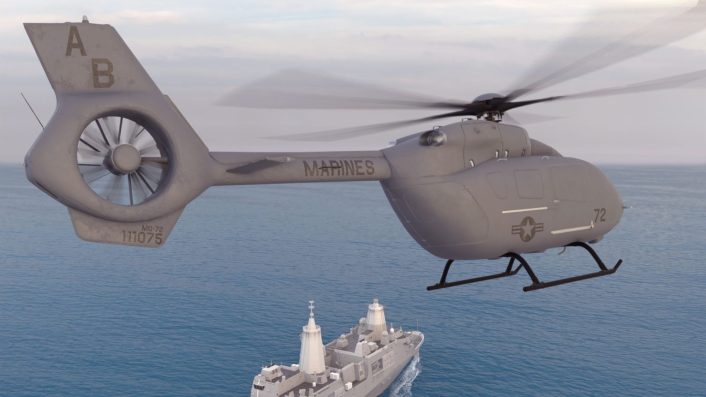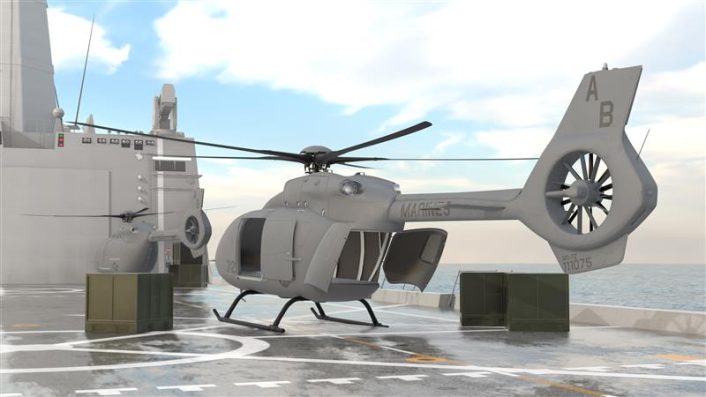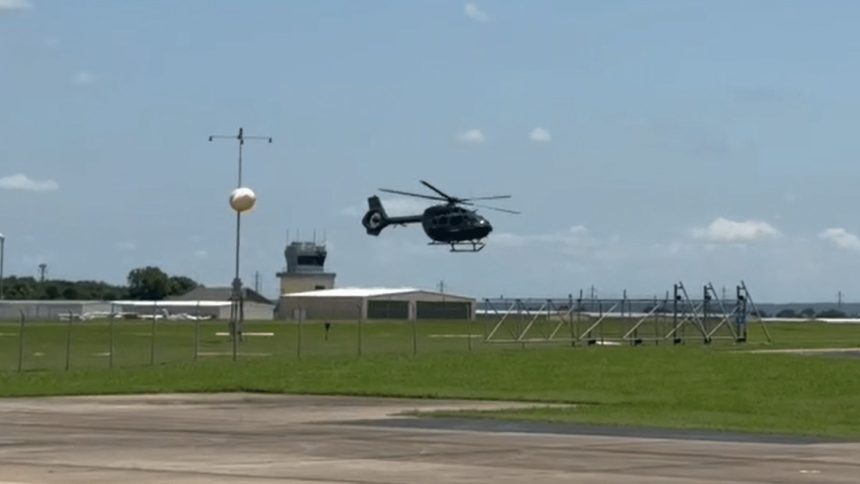Airbus partnered with Shield AI to integrate the latter’s Hivemind autonomous flight software for the U.S. Marine Corps’ Aerial Logistics Connector (ALC) program.
Shield AI and Airbus U.S. Space and Defense announced on Aug. 19, 2025 the flight of the MQ-72C Lakota unmanned rotary-wing platform with the Hivemind autonomous flight software, in support of the U.S. Marine Corps’ ALC (Aerial Logistics Connector) program. The test flight, conducted at Grand Prairie in Texas, saw the MQ-72C, a derivative of Airbus Helicopters’ conventional manned UH-72A Lakota utility helicopter, flown under the “direct control” of Hivemind, while collaborating with Airbus’ own Helionix software.
Hivemind was integrated into the aircraft in “under two months,” following Airbus partnering in April 2025 with Shield AI. Serving as the MQ-72C’s mission systems control, Hiveming performed “auto takeoff, landing, and other test points to illustrate the software’s ability to direct the aircraft without pilot input,” Shield AI’s statement said.
Shield AI and #Airbus are defining the future of helicopter operations – powered by Hivemind.
Hivemind, integrated with Airbus’ Helionix flight system and MQ-72C, successfully completed its first autonomous helicopter test flight as part of the U.S. Marine Corps Aerial Logistics… pic.twitter.com/wMwPjzzzth
— Shield AI (@shieldaitech) August 19, 2025
The UH-72A is a utility helicopter based on the Airbus H145, currently in service with the U.S. Army. The Aerial Logistics Connector effort is one of several across the Department of Defense to deliver logistical support in distributed environments during peer or near-peer conflicts.
Shield said the demonstration validated the stipulated flight characteristics of the UH-72 Lakota platform and the ability to “load and carry specialized cargo,” demonstrating that the aircraft “can be modified to meet Marine Corps requirements for an Aerial Logistics Connector system that supports expeditionary advanced base operations (EABO).”
Shield AI’s Hivemind is also powering GA-ASI’s MQ-20 Avenger UCAV, which has demonstrated simulated Beyond Line-of Sight (BLOS) air-to-air engagements in progressively complex and real-world scenarios.

Shield AI’s Hivemind on MQ-72C
According to Shield and Airbus, the H145/UH-72 base platform, from which the MQ-72C is derived, offers the ALC the proven airframe’s easy logistics, simple maintenance and Open Systems Architecture (OSA) to help “perfect the mission technology,” while checking project timelines, cost and technical risk.
The autonomous logistics capability on the proven UH-72 aircraft, which has logged over 1.7 million flight hours and over 490 aircraft used by the U.S. Army, U.S. Navy and foreign allies, has applications for civilian humanitarian assistance, MEDEVAC and CASEVAC roles too.
Shield AI CEO Gary Steele said in the press release that the latest flight “marks an important validation” of the company’s autonomous flight technology. The company has announced more test activities and demonstrations to validate the Hivemind’s ability to power even “other helicopter variations, in addition to the MQ-72C.”
🇺🇸 Shield AI (@shieldaitech) and Airbus (@Airbus) announced a teaming agreement to integrate Shield AI’s Hivemind autonomy software on the Airbus MQ-72C Logistics Connector.
“Airbus is a world-class partner with a strong track record of delivering reliable systems for the… pic.twitter.com/2agR4l0LYA
— Counter Unmanned Systems (@CUAS_NEWS) May 1, 2025
Airbus’ other partnerships and contracts for ALC
In May 2024, the Naval Air Systems Command (NAVAIR) awarded AUSSD a Phase I Other Transaction Authority (OTA) contract for its UH-72 Logistics Connector concept as a Middle Tier of Acquisition (MTA) route for the ALC program. That contract involved operational demonstrations and experiments.
After teaming up with Shield AI in April, Airbus announced on May 14 a collaboration with L3Harris to integrate digital communications infrastructure and command-and-control into the MQ-72C “for quick integration of third-party commercial hardware, increasing operational flexibility and adaptability in contested environments,” as per reports.
Then, on Jun. 26, 2025, edge software solutions provider Parry Labs and Airbus announced partnering with AUSSD to deliver “autonomy, command and control, and mission capabilities using modern digital and hardware solutions” on the MQ-72C for ALC. Parry Labs will deliver a commercial off-the-shelf (COTS) STRATIA Edge Software Platform, which offers “commercial aviation standards with modern autonomy and mission system capabilities.”

MQ-72C and USMC
The MQ-72C is 13 feet tall, 44.4 feet long, with a maximum takeoff weight of 3,800 kg. The drone can cruise at 250 km/h, touch altitudes of up to 20,000 feet, and distances of over 650 km. Airbus U.S. Space and Defense announced on May 20 the completion of a second program demonstration at MCAS (Marine Corps Air Station) Yuma, Arizona. Chairman and CEO of AUSSD Rob Geckle said that the MQ-72C can “support a range of missions and payloads that Marines will need to perform operations in austere environments.”
The EABO concept envisages small groups of hard-to-detect Marines under the Marine Expeditionary Forces operating from Allied-controlled features in the SCS (South China Sea), conducting standoff ship-strike fires at PLA Navy vessels with missiles like the NMESIS. Other programs taking shape to support this development are Marine MQ-9 Reapers flying with RDESS/SOAR and STII (SkyTower II) network extension, communications relay and data-sharing pods.
Meanwhile, Parry Labs’s edge computing hardware and proven ground control station, that can scale to “multiple form factors,” will also include integration with the Marine Corps’ MAGTAB (Marine Air Ground Tablet). This system was used in the Marine Corps’ Nov. 2024 LRPF (Long-Range Precision Fire) test off an AH-1Z Viper attack helicopter, with the family of missiles later identified as L3Harris’ Red Wolf and Green Wolf Launched Effects.

With the MAGTAB also figuring in the ALC program’s MQ-72C and L3Harris integrating digital communications on that platform, this shows how the Corps is executing complementary launch effects and strike (Red/Green Wolf), airborne communications relay (Reaper/STII), and autonomous logistics (MQ-72C/ALC) programs to support the EABO concept.
Sikorsky’s participation in ALC
Sikorsky also announced on Dec. 11, 2024, that it received a Phase 1 Aerial Logistics Connector OTA from NAVAIR “to demonstrate the maturity and capability” of its MATRIX flight autonomy system. MATRIX is the technological foundation for DARPA’s ALIAS (Aircrew Labor In-cockpit Automation System) program that Sikorsky has developed since 2020.
“Operationally relevant demonstration flights during 2025 using Sikorsky’s Optionally Piloted UH-60 Black Hawk helicopter will inform the service’s Aerial Logistics Connector program how autonomous aircraft can resupply and sustain Marines in contested battlespace,” Sikorsky said.
As The Aviationist reported, the software powers a UH-60A Optionally Piloted Black Hawk which has performed supervised autonomous and full-autonomous unmanned flights in 2021 and 2022. Then, in October 2024, DARPA contracted Sikorsky to equip the U.S. Army’s experimental fly-by-wire UH-60 Black Hawk helicopter with MATRIX.
UPDATE: DC Aviation Disaster
Lockheed Martin, through its subsidiary Sikorsky, has been involved in converting the UH-60 Black Hawk helicopter into an autonomous or Optionally Piloted Vehicle pic.twitter.com/SUcwmyilxM
— QuipQuest (@QuipQuest0) February 1, 2025
Also, on Oct. 17, 2024, the company demonstrated the technology at the AUSA (Association of the United States Army) symposium in Washington D.C. by remotely controlling a UH-60 Black Hawk from 300 miles away. The MATRIX autonomy program also powers Sikorsky’s unique Rotor Wing Blown VTOL (Vertical Take-Off Landing) UAS (Uncrewed Aerial System), of which Sikorsky announced in March the flight of a scale model, validating its control laws software.









